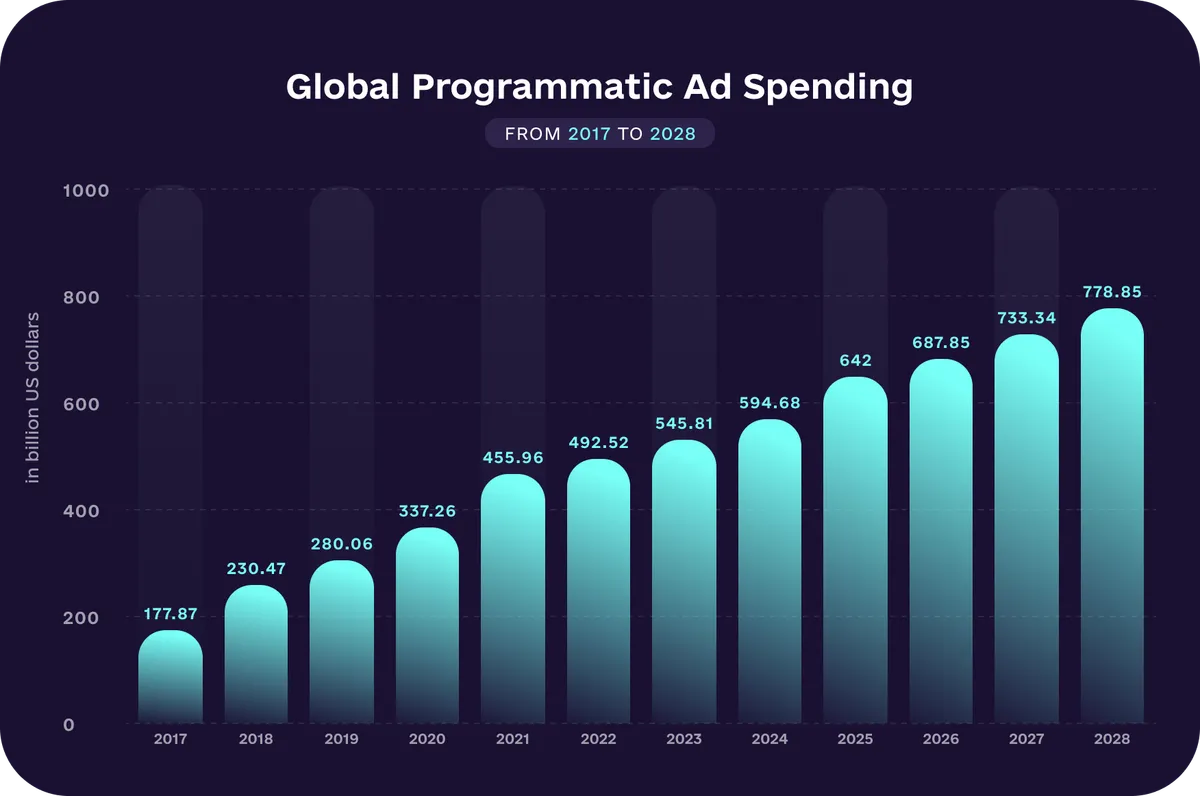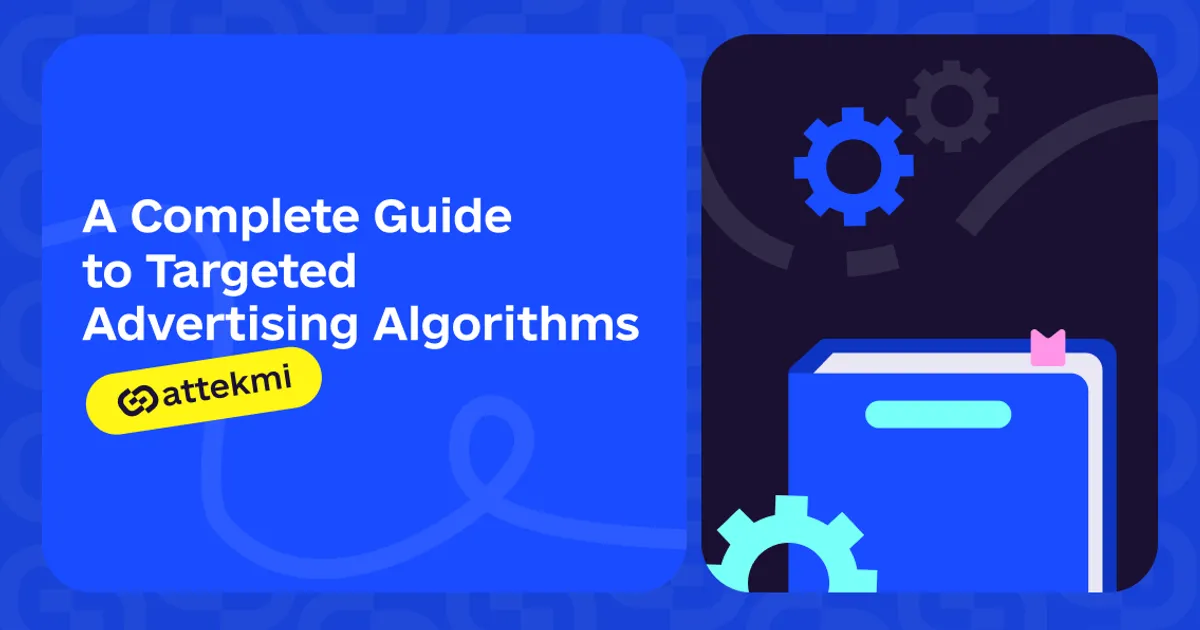The evolution of advertising never stands still, and nowadays, marketers can leverage technology to reach their customers in the most effective way. This is why programmatic ad spending is expected to reach almost $780 billion in 2028.

But what exactly makes programmatic so efficient? What role do advertising algorithms play? What should you consider as an ad exchange owner? This article is here to answer these and other questions.
Key Takeaways
Programmatic advertising relies on algorithms to deliver high-precision, real-time targeting with minimal human intervention.
Algorithms drive cost-efficiency, faster campaign execution, and increased ROI through automated decision-making.
AI and ML are essential for ad personalization, spend optimization, and audience behavior prediction.
Global platforms like Meta, Amazon, and eBay utilize advanced algorithms for ad delivery, bidding, and contextual targeting.
Digital footprints (likes, searches, purchases) are key data sources, though cookie-based targeting is becoming obsolete.
Ad exchanges must be compliant with data privacy laws and offer flexible, filter-rich setups for DSP and SSP connections.
Attekmi solutions provide a no-code interface for targeting configuration, enabling precise partner matching and maximizing ad revenue.
What are algorithms in advertising?
Basically, any algorithm can be defined as a set of rules that must be followed to complete a certain task. Digital advertising heavily relies on algorithms since they allow marketers to reach their target audiences.
For instance, when a user browses a social network, they often see sponsored posts that may be interesting to them. All this happens thanks to algorithms that evaluate the relevance of the content to this specific user according to the targeting settings. Advertising network examples like Google Ads or Facebook Ads are great illustrations of how algorithms power personalized advertising.
Programmatic advertising is also based on algorithms, which allows for minimizing human intervention. Marketers can target specific users and make decisions in real time to improve the performance of their campaigns. They only need to set everything up; the rest is done automatically, thanks to algorithms.
Why is digital advertising getting more and more algorithmic?
Modern programmatic platforms are continuously enhancing their algorithms. Thus, marketers can benefit from a wider selection of targeting options, automated optimization features, etc. More and more advertisers prefer programmatic solutions (which means more deals for you), and here is why this happens:
Increased effectiveness. Advertisers can target exactly those customers who are most likely to convert, and on programmatic platforms, this process happens automatically;
Flexibility. Since advertising algorithms allow for collecting data and making real-time decisions, it gets much easier for media buyers to adjust their strategies. In turn, traditional advertising (for instance, billboards) is not powered by algorithms, which makes analysis impossible;
Cost-efficiency. Using online advertising algorithms means that there is no need to rely on intuition. Everything is based on data, so ads have higher ROI;
High speed. Programmatic advertising may seem to be a complex process, but actually, it is not like that. Marketers only need to set up their campaigns on a DSP. Then, algorithms find a relevant inventory within a couple of seconds, so the ads are displayed to users virtually immediately;
Convenience. Since human intervention is minimized, advertisers can focus on tasks that cannot be automated that much. For you, this is also a benefit. After you connect your DSP and SSP partners to your ad exchange, the system will match them automatically.
Role of ML and AI in advertising algorithms
For advertisers, ML and AI play a vital role. First of all, artificial intelligence and machine learning algorithms for advertising are the core of programmatic as multiple processes involved are possible exactly thanks to them. These algorithms ensure precise targeting and high personalization, ad spend optimization, etc.
Secondly, advertisers can leverage AI and ML algorithms to analyze vast amounts of data, collect insights on their audiences’ characteristics, predict their behavior, and so on. This knowledge can then be used for adjusting campaigns.
And it is not only about targeting and analysis. As an ad exchange owner, you can also benefit from specific applications of ML and AI. For instance, Attekmi solutions offer the adaptive margin feature, a self-learning mechanism that automatically calculates the most optimal margin and allows you to maximize your revenue.
Advertising algorithms on the examples of global brands
Now, to illustrate the performance of advertisement algorithms, let’s review a couple of popular platforms.
Meta
Meta is among the companies that have already implemented ML technology to deliver ads. For instance, Facebook advertising algorithm relies on two factors: audience targeting set up by marketers and the ad auction results. ML is responsible for generating the ad quality score and the estimated action rate.
Along with the bid, these rates take part in calculating the total value score. Ads with the highest score are then delivered to the target users.
Instagram advertising algorithm can also be fine-tuned with multiple targeting settings. In general, advertisers can launch ads on Instagram and Facebook using a single platform since both social networks are parts of the Meta ecosystem.
Amazon
Apart from a standard self-service platform, Amazon also offers a DSP. This Amazon advertising algorithm works like any programmatic solution, allowing advertisers to automate the process of purchasing ad inventory.
Powered by machine learning, Amazon DSP helps marketers improve campaign performance, target previously unaddressed audiences, benefit from contextual targeting, etc.
eBay
To ensure the ultimate experience for shoppers, eBay has launched a so-called Advanced Audience Technology. Ready for the cookieless future, this solution allows advertisers to target even those customers browsing eBay for the first time.
Besides, eBay supports automatic targeting and bidding, although manual targeting is still available to marketers. Another eBay solution, Offsite Ads, is a way for advertisers to reach relevant audiences on external channels like Google.
The power of digital footprints
In terms of targeting, advertising algorithms are so effective because every Internet user has a digital footprint. For instance, these can be previously purchased products, likes on social networks, Google searches, location, etc. This data is used by algorithms to ensure a relevant and personalized advertising experience.
However, it is important to remember that cookies are fading away. Therefore, advertisers should prefer programmatic platforms that do not rely on third-party data and are fully compliant with privacy regulations.
As for you, your ad exchange must be compliant with data processing standards and privacy regulations as well. Note that Attekmi solutions already meet these requirements, so choosing one of them means you will not have to deal with regulations on your own.
How targeting works on Attekmi solutions
As you can see, thanks to effective algorithms, programmatic media buying has a secure spot in the market. More and more advertisers prefer programmatic instead of looking for relevant ad inventory on their own.
But what does this mean for you apart from a higher number of deals? As a current or future ad exchange owner, you will not have to specify audience characteristics for advertisers. They will do this themselves via the selected DSP. As for you, you need to ensure that your DSP and SSP partners can connect effectively via your platform.
On Attekmi solutions, setting up such algorithms does not require coding skills or deep technical knowledge. You can set up an advertising algorithm for each of your partners when creating an endpoint.
For DSPs, you can specify the following parameters:
Ad format (banner, native, video, pop, push, or rewarded video);
Traffic type (desktop, mobile web, in-app, or CTV);
Ad size;
Player size;
Countries;
Connection type;
Device OS;
Sources and publisher IDs;
Spend limit.
Besides, there are many other filters that you can apply to deliver the ultimate experience to your DSP partners.
As for SSP connections, you can specify ad format, traffic type, geo, and ad size. Numerous filters are available here as well.
Note that the more targeting settings and filters you apply when connecting your SSP and DSP partners, the more effective performance your algorithms will deliver. Your platform will match relevant DSPs with relevant SSPs, which means higher trading income for you.
Does Attekmi look like the right choice? Then contact us to learn more!
To sum up
The digital advertising landscape keeps evolving, and a programmatic approach, powered by algorithm advertising, is the most effective way for media buyers and publishers to find each other.
While these parties benefit from algorithms behind demand- and supply-side platforms, you need to match your DSP and SSP partners efficiently to ensure the proper performance of your ad exchange. Therefore, pay special attention to targeting settings when connecting partners to the system. The more settings you apply, the better. Besides, continuously analyze the results your platform delivers. This will help you identify opportunities and potential weaknesses, as well as allow you to adjust targeting.
FAQ
No. However, to match your SSP and DSP partners effectively, we recommend you to configure as many parameters as possible. This will ensure the effective performance of targeted advertising algorithms and your ad exchange in general. As a result, your income will grow.
Sure, our products are very flexible. Feel free to adjust targeting settings when needed to improve your solution’s advertising algorithms and maximize its performance.
Our team is always here to help you, and we will be glad to assist you with integrating your SSP and DSP partners. And since this process involves configuring targeting, there is no need for you to worry.
 By Anastasiia Lushyna
By Anastasiia Lushyna